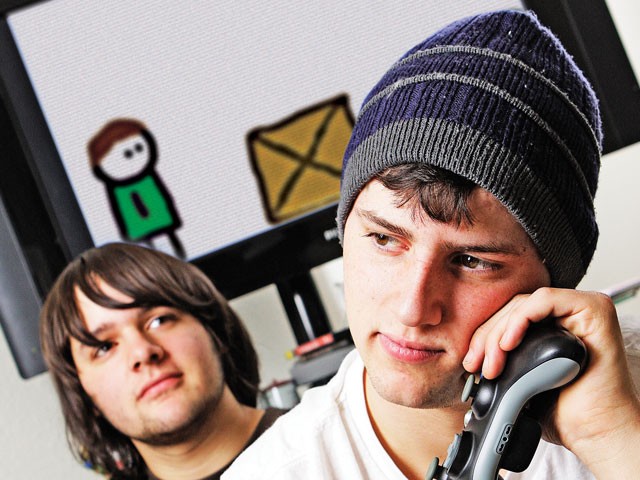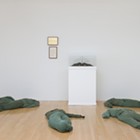A kid named Jon walks into an ominous factory. He’s lost his dog. All he finds, though, are level after level of gravity-defying platforms and labyrinthine paths and murderous robots. The factory is so tangled and huge, there’s no way a mere child could jump and climb and snake around. Good thing Jon found an assortment of balls with an assortment of powers that balls don’t usually have: the power to overcome gravity, to burn through solid surfaces like acid and even to rupture the fabric of space-time and create a wormhole that can propel Jon from one place to another. The (meta?)physics of these magical balls are never explained, but that’s not important. This is a 2D world and we’re trying to have fun here.
Anyway, the balls are Jon’s passport into this technological heart of darkness.
The balls also took Dylan Nelson, 17, and his brother Keith, 19, on a wild ride. As the designers of a videogame for Xbox called Have a Ball, they rode their imaginations all the way from the basement of their South Hill split-level to the campus of one of the gaming industry’s juggernauts.
When Dylan told Keith about Unlock XBox, a Doritos and Microsoft marketing-blitz-cum-game-design competition, they started batting ideas back and forth.
The competition was to create a game for Xbox Live Arcade, which meant there were certain restrictions. The games needed to be downloadable, which meant they had to be simple, “with no, like, complex graphics or anything,” Dylan says. The rules didn’t say this outright — it was just his analytical, 16-year-old (at the time) mind reaching conclusions. The brothers first came up with the idea to have packs of heroes go around trying to kill packs of murderers — a cooperative horror game in the vein of Left 4 Dead, Dylan explains. But this felt needlessly complex too, in the gameplay department. Simplicity seemed like the thing, all around.
To alleviate the brainstorming tedium, they started tossing a ball around. This gave Dylan an idea for a platform game (two-dimensional, where players try to get from point A to B, like the original Super Mario Brothers) with puzzle-solving elements. Rather than running and hopping on turtle shells — you’d be kinda trapped and have to find ways up and around massive obstacles and lasers and robots and all that. You’d be just a kid, not strong. You wouldn’t have a gun. You’d need to use a little guile. The vehicle for that guile, well … You’d have these balls, see, and … There’d be a limited number of balls, the brothers decided, for each level, to make things difficult, and a somewhat open structure, so that you could use any one of several combinations of balls to complete each level. The trick, though, was deciding which to use and where. You wouldn’t want to use a teleport ball when a platform ball would suffice, because there might come a time when only the teleport ball would work, and the platform ball would be useless.
They called the game Have a Ball. As far as concepts go, it was a lot like Nintendo’s iconic mid-’80s A Boy and His Blob — the game that effectively established the platform-puzzler genre.
It’s simple and a little absurd, but the logic puzzles and the incremental increases in difficulty are just the kind of thing, the brothers believed, that gets obsessive geek types foaming at the brain-mouth.
The judges agreed, putting Have a Ball in their top eight out of what Dylan estimated were 1,500 entrants. Which earned the brothers a trip to Microsoft for a four-day planning session culminating in a pitch to a panel of game designers, a la ABC’s Shark Tank.
Well, it earned Keith that trip. Dylan was under 18 and thus unable, technically, to participate. He had to find his own way over. His mom, Belinda, drove him.
It was made quite clear that we wouldn’t be venturing down into the basement, where the boys conceived of the game while tossing a ball back and forth. “Too messy,” Dylan had said over the phone, paraphrasing his mother.
The brothers, ages 17 and 19, were the youngest to reach the round of eight. Yet their game concept is, by a large margin, the most mature.
In Thrown, created by a San Diego man named Jason, players drive around trying to ram their opponents, then running the players down after they’ve been ejected from their cars, for instance.
In Harm’s Way, the objective is roughly the same: winning races by killing, maiming or otherwise disabling your competitors. Rather than vehicular homicide, though, you play with a friend, one driving, the other sniping with a high-powered rifle.
Playing the role of taciturn teenage males well, both brothers remain impassive about whether or not this experience has made them want to jump into game design as a career. “It’s definitely something I’ve thought about,” says Dylan, not keen on elaborating.
Keith acts more excited about the prospect of game design, though only Dylan has plans for college. “It’s all I can think about.”
Keith’s extra enthusiasm may be due to his being allowed to hang out with game designers while in Seattle. He described a work environment that feels very much like teenage-boy nirvana. “There were snacks,” he says — soda, anything you wanted. “[The designers] were just sitting around talking.”
Nirvana became purgatory, though, when it came time to actually turn the brothers’ vision into a concrete game pitch. Keith spent the bulk of each day working on writing the pitch and building a Power- Point presentation, then made a list of tasks to accomplish at the hotel each night, when Dylan could help.
The game pitch went well, and videos on the Website (now removed) showed how the judges — designers and game journalists — were impressed with the simplicity and elegance of the concept.
But the judges didn’t ultimately decide the winners. In true faux-democratic marketing-gimmick form, fans of Xbox and Doritos were directed to the Website to vote on their favorites.
And that’s where the brothers’ magical ride came to an end. The top three spots went to Thrown, the hit-and-run game; Harm’s Way, the drive-and-snipe game; and Avatar Crash Course, described as “high-energy, crazy, and full of comical mishaps and fun for you and your friends.” Three games in which it pays to be a terrible driver, essentially.
Maybe it’s just as well. Keith and Dylan, though they loved the experience, say it was daunting in a number of ways. The final night before Keith’s presentation was especially grueling for the brothers, the two frantically working until nearly 3 o’clock in the morning. “It felt like work,” Keith says.


















